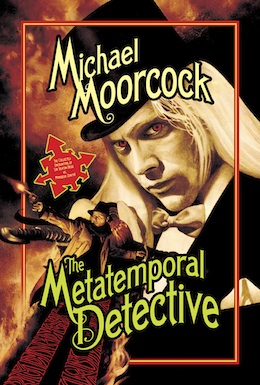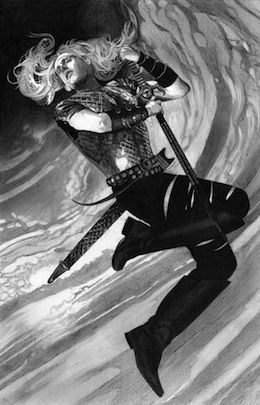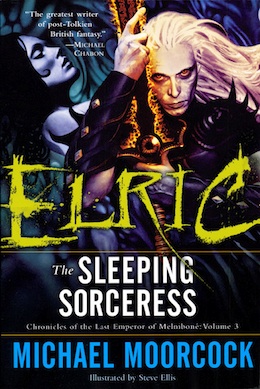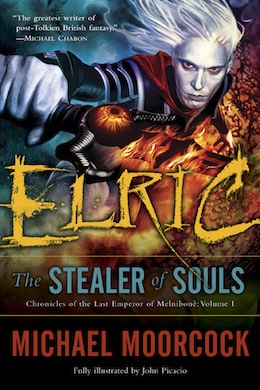Texas-based illustrator John Picacio has been nominated for the past five consecutive years for the Hugo Award in the Best Professional Artist category, and has won the World Fantasy Award, the Locus Award, three Chesley Awards, and two International Horror Guild Awards. He is an icon in his own right, one of the most sought-after artists in our field. As such, he has created covers for some of the biggest names in science fiction and fantasy, names like Frederik Pohl, Robert Silverberg, Harlan Ellison, Hal Clement, L.E. Modesitt, Jr., Dan Simmons, James Tiptree, Jr., and many more. But one sees when looking back on his career that he’s had a long association in particular with Michael Moorcock, having illustrated seven books for the Grand Master thus far. I caught up with John to talk about his various and varied work across the Multiverse.
Anders: I discovered Moorcock before I could drive. I’d come to him from out of a glut of Edgar Rice Burroughs, and his brand of sword-heavy fantasy was a natural transition from the lands of Barsoom, Amtor, and Pellucidar. But Moorcock’s work had a sharper edge, a more cynical and dangerous tone to it, and there were works like Behold the Man which were utterly outside the realm of anything I’d ever been exposed to as a kid growing up in the Deep South and attending a school affiliated with his church. He blew the doors of my perception wide open. Tell me about your first encounter with his writing.
Picacio: Behold the Man was my first Moorcock read. That was my first pro illustration gig actually—illustrating and designing the thirtieth anniversary edition of that book. Looking back, I’m appalled by my work on it, but that’s where my pro illustration career started. When I got the assignment, I naturally read the book in preparation for the work, it blew me away too. It changed my life – not only was it the first gig of my career, but because of it, I met Mike and his wife Linda. I remember how happy and consumed I was doing that job. I felt free, and I felt like it was what I most wanted to do in the whole world. The sheer pleasure of doing that job made me shift my career direction away from architecture and toward being a fulltime pro illustrator and artist. Growing up, I knew the name “Michael Moorcock” more as a mythological concept than as an author. He’s still mythological to me in a lot of ways, but he’s also a good friend, and he and Linda are amongst my very favorite people. I’d take a bullet for those folks.
Anders: You did Tales from the Texas Woods the year after that, but then you wouldn’t come back to Moorcock until 2005 when I hired you to do the cover of his novel, Silverheart, co-written with Storm Constantine. Silverheart is an interesting novel. It began life as a videogame concept, but when the game fell through, Mike turned over the 30,000 or 50,000 words he had written to Storm to work it into a novel. It was published in the UK (with a cover by Jim Burns) but not published in the US until Pyr brought it out in our first year. Despite being co-authored, it’s absolutely part of his Eternal Champion series, with Max Silverskin a very clear incarnation of his reincarnating protagonist, and Karadur, his city, said to lie in the very heart of the Multiverse. Let’s talk a little bit about that cover.
Picacio: I did the illustration and design on that one. Mike and Storm’s names needed to be sized large on the cover. Mike’s name was gonna sell that book more than the title, but at the same time, it seemed like the cover didn’t want to be big words with a boxed illustration. So I went for a full bleed illo and tried to do big type and have key, evocative bits of the illo read around the type. It’s been a few years. I’ll bet I could it better now if I had to do it all over again.
 Anders: You come back to Moorcock in 2007 with The Metatemporal Detective. This is a collection of Mike’s Sherlock Holmes/Sexton Blake-type consulting detective, Sir Seaton Begg and his Moriarity-like opponent, the albino villain, Monsieur Zenith. Some people may not know that Moorcock’s most famous creation, Elric of Melniboné, was inspired by Sexton Blake villain, Zenith the Albino. In these tales, Moorcock pays tribute to both Blake and Zenith by making them both aspects of the Eternal Champion, fighting on opposite sides of the Law and Chaos divide (though always ultimately for the sake of the Cosmic Balance). This was an interesting assignment because Mike had just tapped you for the first of the Del Rey reissues. This was fortunate in that the research you had begun to do into Elric could come into play for Zenith as well, as Zenith IS Elric (in more ways than one).
Anders: You come back to Moorcock in 2007 with The Metatemporal Detective. This is a collection of Mike’s Sherlock Holmes/Sexton Blake-type consulting detective, Sir Seaton Begg and his Moriarity-like opponent, the albino villain, Monsieur Zenith. Some people may not know that Moorcock’s most famous creation, Elric of Melniboné, was inspired by Sexton Blake villain, Zenith the Albino. In these tales, Moorcock pays tribute to both Blake and Zenith by making them both aspects of the Eternal Champion, fighting on opposite sides of the Law and Chaos divide (though always ultimately for the sake of the Cosmic Balance). This was an interesting assignment because Mike had just tapped you for the first of the Del Rey reissues. This was fortunate in that the research you had begun to do into Elric could come into play for Zenith as well, as Zenith IS Elric (in more ways than one).
Picacio: Yeah, Metatemporal Detective was a fun cover. For me, the most memorable thing about that job wasn’t the cover, but creating the spine, and how that came together. Remember that? I was in the green room at my wedding, waiting for the ceremony to start. Mike was sitting there with me. You were there too. He’d seen a rough version of the cover art. He was really happy with it, but he wondered if there was any way to put the female protagonist, Rose, somewhere on the cover. I think by that point, I’d already designed the typography and I was almost done refining the final art. So it was gonna be a major chunk of time to reinvent it, but I love Mike, so I said “You got it. I’ll figure out a way.” Someone poked their head through the door and gave us the greenlight that the ceremony was about to start and I think you leaned over to me as we were walking out and whispered, “What if she wasn’t on the cover but somehow was on the spine?” As I’m walking down the aisle, heading toward marriage, and vows are being vowed, that spine is shaping itself in my head and by the time I said “I do”, I figured it out. When the book was published, I think Mike was thrilled with the result. And somehow, my wife still loves me.

Anders: So now we’re up to Elric: The Stealer of Souls, the first of Del Rey’s six volume reissue of the Chronicles of the Last Emperor of Melniboné. You did covers and interiors on this, then a cover on the third book, and will be doing covers and interiors on the final volume as well. But let me say – no character in fantasy fiction, I dare say not even Tolkien’s Fellowship or Howard’s Conan, has been represented in art this many times. Just a quick Bing image search brings up several thousand results. How do you go about taking on an assignment like that? I know a lot of artists would have just sat down to draw Elric from out of their own pools of nostalgi—white skin, black sword, go. But you didn’t do that. You went back and studied the entire history of Elric in illustration. You spent hours in conversation with Mike. You went over the source texts with a fine tooth comb. And you studied up on the appropriate weaponry too. Tell me about this.
Picacio: Elric is more than a character. He’s an icon. He’s got a worldwide fan following that spans almost a half-century. So many greats have illustrated their own versions over the years and I wanted to do my own, apart from what had been done before. I spent two days studying the entire visual history of Elric and absorbing all interpretations of what had been done before. I looked at everything. And I did that so that I could then just put it all away and not look at it again. Elric’s past was out of my system. It gave me perspective and let me know what I was up against, and that somehow made the job more manageable.
I did visit Mike in the early stages of my work, and went up there to share thoughts and gather insights from him. I had a chance to present Elric to a new generation of readers and thought he might have a lot to say on the matter. We talked for several hours. Actually, I think I talked, and Mike did a lot more listening that I wanted. He didn’t say much, but was always encouraging. At one point, I was trying to nail down all the minutiae of Elric and I had all these tedious questions about the nature of Stormbringer and on and on. Mike didn’t say much, was patient, nodded his head appropriately here and there, and after a few hours just smiled and said, “Hey, in the end, it’s just rock n’ roll.” And those turned out to be the magic words.
 Anders: Up until your entry, Michael Whelan’s cover for Stormbringer was always the quintessential Elric to me. Your Elric was the first to actually rival Whelan’s for the definitive position, and maybe even unseat it. A lot of that to me is in Elric’s expression. He isn’t Conan. He’s really the anti-Conan, and his brooding and his depression and his haughty self loathing are essential to the character. Tell me about capturing the soul of the stealer of souls. The Chaos symbol is one of the most powerful sigils in fantasy fiction. I’d only ever imagined it as it was described, as eight arrows radiating from a central hub. But you took it to its essence and broke it wide open.
Anders: Up until your entry, Michael Whelan’s cover for Stormbringer was always the quintessential Elric to me. Your Elric was the first to actually rival Whelan’s for the definitive position, and maybe even unseat it. A lot of that to me is in Elric’s expression. He isn’t Conan. He’s really the anti-Conan, and his brooding and his depression and his haughty self loathing are essential to the character. Tell me about capturing the soul of the stealer of souls. The Chaos symbol is one of the most powerful sigils in fantasy fiction. I’d only ever imagined it as it was described, as eight arrows radiating from a central hub. But you took it to its essence and broke it wide open.
Picacio: That’s really kind of you. You’re embarrassing me. Elric fans are hardcore and it’s always nice to hear that the imagery is connecting. The whole history of Elric imagery is an ongoing visual conversation, but the basic gestalt of the character remains just as powerful now as it did in the 60’s and ‘70s. Visually, I think the attitude is everything with Elric. Mike once said that he saw Conan as having the paternalistic, quasi-right-wing values of a John Wayne film, and when he created Elric, he was countering that archetype as a more left-wing, James Dean-inspired point-of-view (I believe this is the late 1950’s/early 1960’s when he’s doing this, along with James Cawthorn). I can totally relate to that. So understanding Elric’s roots was key, but I think part of the timeless attraction of Elric is he’s the personification of the angst that everyone has. I figured if I could tap into that, but illustrate it in a way that felt like he could walk through your door, then I’d be able to make it personal and potent.
Anders: Okay, the sword itself. Cause we gotta. I’ll never forget the night in Texas you, me and Chris Roberson got to swing around Mike’s actual prototype in the parking lot of a Mexican restaurant. Tell me what went into determining what Stormbringer looked like and creating a definitive version of a dark, living evil blade.
Picacio: Yeah, that was fun, wasn’t it? That sword seemed heavily based on Michael Whelan’s version and I thought it was terrific. That said, I felt like it was important to create my own and try to extend the visual vocabulary. I treated Elric’s sword as if it was a character unto itself. I wanted to do my own take on Elric and approached the sword the same way. I thought if there was ever a Hollywood film of Elric or if this guy really existed in our world, his sheer appearance with those piercing eyes would probably scare the hell out of people when he first walked in the room. And I always pictured his sword having a big eye that moved, blinked, and had a mind of its own. I think the sword would constantly be in flux and I think the runes on its blade wouldn’t necessarily stay constant. For one version of the sword, I worked out a runic way of writing “a thousand times more evil than thou” so that if anyone could read runes, they might be able to figure out.
 Anders: With seven covers, and three books worth of interiors (Behold the Man also featured interior work), you have got to be up there now as one of the top illustrators of Mike’s worlds, just in terms of volume, let alone accomplishment. Behold the Man was the job that brought you into cover illustration. How has the massive undertaking that is the Del Rey reissues altered or advanced your career trajectory? I know you are currently in the midst of the George RR Martin calendar, which is a massive undertaking. Do you think it evolved out of your work on Elric—or that your work on Elric evolved you in such a way that it was in aid of these massive, high profile projects? In other words, what have you taken from this and where has it lead you?
Anders: With seven covers, and three books worth of interiors (Behold the Man also featured interior work), you have got to be up there now as one of the top illustrators of Mike’s worlds, just in terms of volume, let alone accomplishment. Behold the Man was the job that brought you into cover illustration. How has the massive undertaking that is the Del Rey reissues altered or advanced your career trajectory? I know you are currently in the midst of the George RR Martin calendar, which is a massive undertaking. Do you think it evolved out of your work on Elric—or that your work on Elric evolved you in such a way that it was in aid of these massive, high profile projects? In other words, what have you taken from this and where has it lead you?
Picacio: It never occurred to me that I’d done a lot of work with Mike until you added it up. The Del Rey reissues have been an honor to illustrate. Justin Sweet, Mike Kaluta, and Steve Ellis have done some terrific artwork on those books as well. I’m still finishing off the interiors for the sixth book. The cover’s been turned in and so have much of the interiors. I was finishing off that job which is published by Del Rey, and then Bantam which is owned by the same parent company (Random House) tapped me to illustrate a George R.R. Martin calendar for A Song of Ice and Fire. I was concerned that I still needed to finish that work for Elric, but it’s the same parent company so I figured they knew best. They said they really needed me to start working on that calendar so I took the gig. Besides, when George R. R. Martin personally requests you, you don’t turn him down.
I’d approached George at Worldcon in Denver and said, “hey, if there’s ever an opportunity down the road to work together, I’d like that.” Fast forward to the 2009 Worldcon in Montreal a year later, and George said, “hey, there’s this calendar I want to do….” He specifically mentioned that he dug the work I did on Elric. So yeah, the Elric work certainly did lead to my current gig illustrating a calendar for A Song of Ice and Fire. I’m working hard on it right now.
Both jobs have been big learning experiences. I carry a pretty full cover schedule and I think ideally, it’s best to work on bigger multi-picture jobs with a little lighter load, but I’m getting there. In future, I’ll probably weigh that when I consider jobs. I’ve learned some tough lessons about time management and just the simple truth that I can’t carry everything at once. I’ll get better at it. I think working on lots of covers is like an ongoing series of intense sprints and working on one big, singular illustration project is like a marathon. It takes different mindsets to accomplish each. I’ve become a pretty accomplished sprinter over the years, and I’m hoping I’ll be a better marathon runner after I finish the Elric and ASOIAF jobs. In future, I’ll probably moderate a little more, and avoid running 10 to 12 major sprints while I’m trying to run a marathon. Time to reflect later though—I’m working hard to finish these right now.
Anders: Let’s talk about Mike himself, one of the most important figures in the history of both science fiction and fantasy. His editorial leadership on New Worlds and championing of the “New Wave” changed the science fiction genre forever, and his influence on the fantasy genre rang out through the field and spilled over into gaming, videogaming, rock and roll, anime, film. His term “Multiverse” is now how most quantum physicists see our universe as actually being. His influence is everywhere. To be such a giant, he’s a hell of a down-to-earth guy. I know what he means to me. What does he mean to you?
Picacio: I’m not someone who grew up with Mike as an influence. I was in my mid-twenties when I encountered Behold the Man, but since then, he’s undoubtedly been a huge influence on my life and career. Look at my first gig on Behold the Man and how that was the pivot point that shifted me from a life in architecture to a life in sf/fantasy illustration, and carry that through the more recent Elric gigs. He’s been a massive influence on the professional good that has come to me. More than work and career though, he set a tone for how I approach what I do and how I see the world. When I first met him, I asked him if he had particular requests or input as to how I should illustrate Behold the Man. His response was “you’re the artist; you’ve got the talent; it’s your job to figure it out.” I think most authors in his position would’ve taken a green rookie and said “here’s what I want you to do”, but not Mike. He treated me with respect, as an equal, and I’ve never forgotten that. It was the right thing to say at the right time, and I’ve never looked back. It’s my job as an illustrator to lead, to illuminate, and to problem-solve, and not just be a hired hand. Be bold. Be visionary. Mike taught me that.
When I first met him, he had particular world views about politics, class systems, and pop culture. I wasn’t necessarily prepared for those viewpoints, and some of the details may have jarred with my upbringing and the limited way I saw the world at the time. His words stuck in my head for years though, and they’ve become much clearer and more resonant. He expanded my world view. Mike’s one of the most generous people I’ve ever met, both personally and professionally. There’s a lot of public figures who would reach his stature and rest on their laurels, or build themselves as the center of self-glorification, but not Mike. He’s a giant who always maintains his roots as a man of the people, and I can’t think of a single figure in the sf/fantasy field that has better influenced the lives and careers of so many. He’s one of the all-time greats, and the best thing is, he’s not done yet.
For more on John Picacio:
blog: johnpicacio.com/blog.html
twitter: twitter.com/JohnPicacio
facebook: facebook.com/johnpicacio
Lou Anders is the editorial director of Pyr books, a Chesley award-winning art director, and the editor of nine-critically acclaimed anthologies. It was his privilege to publish Michael Moorcock’s Silverheart (written with Storm Constantine) and The Metatemporal Detective, as well as an original Elric story due out this summer in the anthology Swords & Dark Magic (co-edited with Jonathan Strahan).










